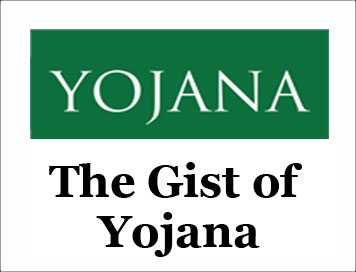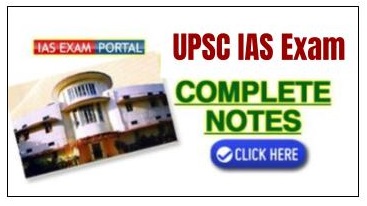(HOT) UPSC Current Affairs 2025 PDF
NEW! The Gist (NOV-2025) | E-BOOKS
(GIST OF YOJANA) MAKING WATER SOURCES SUSTAINABLE
GIST OF YOJANA : MAKING WATER SOURCES SUSTAINABLE
SEPTEMBER-2025
MAKING WATER SOURCES SUSTAINABLE
Context:
Water is the first element offered to a guest and the last poured during a funeral. It nourishes our fields, runs through our rituals, and sustains our dreams. Yet, over the past few decades, this elemental force, so vital and so vulnerable, has come under unprecedented stress. Erratic rainfall patterns, rising temperatures, unchecked over-extraction, pollution, and growing demands from a booming population have put our water sources under strain. For a nation that holds just 4% of the world’s freshwater and sustains nearly 18% of its people, this is not merely a crisis; it’s a call to action.
Challenges in recent decades:
-
Erratic rainfall patterns.
-
Rising global and local temperatures.
-
Over-extraction of groundwater.
-
Pollution of rivers and aquifers.
-
Population-driven demand.
India’s water paradox:
-
Holds only 4% of global freshwater.
-
Supports 18% of the global population.
-
Shift in approach: from extraction to conservation, dependency to decentralisation, scarcity to sustainability.
The Tap that Changed Everything – Jal Jeevan Mission (JJM) Past reality:
-
Women and girls walked miles daily with heavy pots.
-
Unsafe water led to diseases.
-
Social costs: lost schooling, poor health, wasted time, and loss of dignity.
-
JJM launched in 2019 with vision: Functional Household Tap Connection (FHTC) in every rural household.
-
Achievements: Over 15.67 crore rural households now have tap water.
Impact:
-
Empowerment of women (from water carriers to water managers).
-
Formation of Village Water & Sanitation Committees (VWSCs).
-
Women test water quality, draft security plans.
-
Improved education (girls remain in school).
-
Better family nutrition and hygiene.
-
Efficient irrigation practices.
-
Dignity and time restored to households.
Recharging the Future – Catch the Rain Campaign:
-
India’s rainfall: heavy but short-lived during monsoon.
-
Traditional wisdom: stepwells, tanks, ponds – once effective but neglected.
-
‘Catch the Rain’ campaign–public movement with slogan “Catch the rain, where it falls, when it falls.”
Five focused interventions of JSA-CTR:
-
Rainwater harvesting & conservation.
-
Geo-tagging and scientific water inventories.
-
Jal Shakti Kendras in all districts.
-
Intensive afforestation drives.
-
Large-scale awareness generation.
Achievements:
-
Rooftop harvesting in schools, offices, railway stations.
-
Over 2.5 lakh Amrit Sarovars (revived ponds, lakes).
-
Tools: remote sensing, GIS mapping, digital dashboards.
-
Community initiative – Jal Sanchay Jan Bhagidari (JSJB):
-
Promotes artificial recharge structures & borewell shafts.
-
Uses multiple scheme convergence for groundwater recharge.
-
Ensures transparency and community participation.
Managing Wastewater – A New Mindset
-
Earlier perception: wastewater = waste.
-
Now: wastewater = resource.
-
Swachh Bharat Mission (Grameen) Phase II (SBM-G):
-
Phase I: achieved ODF India.
-
Phase II: ODF Plus Model → solid & liquidwaste management.
-
Guiding principle: 3Rs – Reduce, Reuse, Recycle.
Examples of reuse:
-
Greywater irrigates kitchen gardens improves nutrition.
-
Low-cost soak pits, leach pits, wetlands recharge groundwater.
-
Treated industrial effluents reused for agriculture → reduces freshwater demand.
Technological interventions:
-
Bio-remediation units – Tamil Nadu.
-
DEWATS (Decentralised Wastewater Treatment Systems) – Maharashtra.
-
Vermifiltration – Odisha.
Impact:
-
Cleaner villages, greener surroundings.
-
Enhanced agricultural productivity.
-
Shift in social attitude: communities treat wastewater as wealth.
Rainfall Data and Technology for Governance
-
Automated Rain Gauges (ARGs):
-
Real-time rainfall data to Panchayats.
-
Enables water budgeting and planning.
-
Decisions on soak pits, check dams, storage structures.
Digital platforms:
-
Meri Panchayat App.
-
JJM dashboard.
Outcomes:
-
Transparency and trust in governance.
-
Preparedness for floods/droughts.
-
Empowered local institutions with science backed decisions.
Groundwater – Atal Bhujal Yojana (Atal Jal) Importance:
-
60% irrigation from groundwater.
-
85% of rural drinking water dependent on it.
-
Problem: Over-extraction, loss of recharge zones, falling aquifers.
-
Solution: Atal Jal Yojana (World Bank supported).
-
Covers 8,000 Gram Panchayats across 7 stressed states.
-
Promotes community-led groundwater budgeting.
-
Villages map aquifers and create Water Security Plans.
-
Farmers shift to less water-intensive crops.
-
IoT sensors, mobile apps, AI dashboards empower local monitoring.
Impact:
-
Reduced water conflicts.
-
Collaborative governance.
-
Preservation of groundwater for future generations.
Reviving Rivers – Namami Gange and Beyond
-
Rivers as lifelines: Indus, Ganga, Brahmaputra, Godavari etc.
-
Problems: urbanisation, industrial pollution, encroachment, sand mining.
Namami Gange achievements:
-
150+ sewage treatment plants (operational/under construction).
-
Online monitoring of industrial effluents.
-
Cleaned & rejuvenated ghats across 100 towns.
-
Extended efforts: rejuvenating smaller rivers, nalas, ponds.
-
Eco-restoration measures: desilting, tree plantation, riverbank protection.
-
Outcome: restored ecosystems, stronger cultural and economic ties.
Partnerships that Enable Change: Government + Society model
-
SHGs – build soak pits, maintain toilets, spread awareness.
-
Startups/entrepreneurs – affordable tech for water testing, filtration, metering.
-
CSR initiatives – harvesting structures, WASH in schools, campaigns.
-
International partners – UNICEF, World Bank, Gates Foundation support with expertise and best practices.
-
Result: Ecosystem of accountability, shared responsibility, and innovation.
A Tapestry Woven by All – People’s Movement: Driven by individuals and communities
-
ASHA workers building soak pits.
-
School children conducting water audits.
-
Sarpanches mobilising villages for pond cleaning.
-
Farmers adopting sustainable cropping.
-
Mothers ensure water testing at household level.
-
Water sustainability is becoming a daily practice, not just policy.
Way forward and Conclusion:
We still have a long way to go. Climate change will continue to challenge our progress. Population growth will increase pressure on our resources. But we are more prepared than ever, backed by robust policies, powerful data systems, strong community institutions, and a vision that is both ambitious and inclusive.
Our dream is a Jal Surakshit Bharat, where every home has access to safe water/ where every river is alive-where every village is resilient, and where water is seen not as a commodity, but as a common good. We owe this to our children. We owe it to our future. And we owe it to the sacred relationship that our civilisation has always had with water.
CLICK HERE TO DOWNLOAD FULL PDF
CLICK HERE TO DOWNLOAD UPSC E-BOOKS
Study Material for UPSC General Studies Pre Cum Mains
Get The Gist 1 Year Subscription Online
Click Here to Download More Free Sample Material
<<Go Back To Main Page
Courtesy: Yojana



